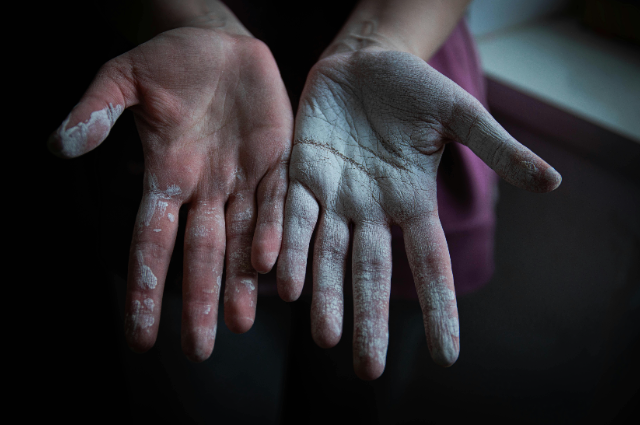
This article is about stains. What about stains? I have no idea. As I opened the Google Doc to write this, the first word that struck me was stain. There is a sense of aftermath to it, of something that has already happened but continues to live on in a mark. A stain is proof of a moment that can’t be fully erased.
The first thing I think of is mehendi stains. I grew up in a mildly conservative Muslim family, and Eid and marriages always meant mehendi. The ritual began with two quests: the right design and the right person to draw it. Back then, Pinterest and Instagram hadn’t yet invaded our small lives. We relied on a few grainy Google searches, maybe a cousin who brought a printed sheet of designs. Then came the queue—one after the other, all of us cousins and friends lining up in front of that one artistic girl who had steady hands. By nightfall, our palms would be sticky with dark orange paste, and when we woke up the next morning, the designs bloomed into deep red. Over the next days, the stains would fade—brown first, then a ghostly yellow, until only faint outlines remained.
Mehendi stains carried the afterlife of celebration. They marked our participation in joy, in rituals of beauty, in a femininity I never fully identified with but still shared. Even after the functions ended, I would catch sight of the stain on my hand during class or while eating, and it pulled me back into the memory. The stain was a reminder: you were there, you belonged.
Not all stains feel like belonging, though. Some humiliate. Food stains, for example, have that duality. They are part of intimacy and part of embarrassment. My mother used to scold me for spilling curry on my clothes - especially turmeric, which refuses to leave, its bright yellow mocking every attempt at washing. Grease stains on the sleeves of kurtas, oil drops on dupattas, tea splashes on college notes: they tell their own stories of rushed meals, clumsy movements, or simply being too absorbed in conversation to notice. Food stains are evidence of living, of sharing meals with others, but they are also socially policed. To be “messy” is coded as careless, sometimes even shameful. Yet I can’t help but think food stains are also traces of intimacy. You do not spill when you eat alone with a rigid posture. You spill when you are at ease, when you are comfortable enough to laugh mid-bite.
Then there are stains of ink. I’ve always been surrounded by stationery, and stains have followed me through exam halls and late-night writing sessions. Ink blotches that smudge entire answers, highlighters bleeding neon through thin notebook paper, sticky notes leaving behind pale rectangular shadows even after they are peeled off. Stationery stains are the footprints of thought. They show revision, mistake, correction, or simply the urgency of trying to capture an idea before it escapes. Unlike turmeric stains or lipstick marks, ink stains rarely embarrass. They carry a different romance - the romance of drafts, of labor, of a life spent in dialogue with words.
But stains are not always romantic. Some bring shame or fear. Blood stains, for example. Menstrual blood, in particular, is still treated as a stain of stigma. Generations of girls have rushed to wash uniforms in hostel bathrooms, terrified of being caught with that bright red mark. Unlike mehendi, which announces celebration, menstrual stains are hidden, denied, silenced. Yet they are the most natural of stains, the body reminding us it exists. Other blood stains carry different connotations: the cut on an arm, the wound that refuses to clot, the scar that begins as a stain on bedsheets. These stains force recognition of pain, whether or not others want to see it.
Lipstick stains occupy another corner of intimacy. A mark on a cup, a shirt collar, or even a page - these are stains that suggest presence, closeness, even desire. Like mehendi, they have an afterlife, lingering after the person is gone. I remember once sipping tea and noticing my own lipstick print on the rim of the cup. For a second, I felt doubled - both present and absent, the cup holding proof that I had been there. That’s the thing about stains: they are testimony.
Not all testimonies are personal. Some are political. I think of walls. My hostel room wall at NALSAR was scarred with stains - paint peeling, ink marks, scribbled slogans, and affirmations. Over time, I added to it: queer-themed art, a Che Guevara quote, and the Constitution’s Preamble. Those stains turned into a living canvas, an archive of survival and politics. They were not pretty, but they carried meaning. To stain a wall is to claim it, to refuse erasure. Protest banners, too, carry stains of paint, dust, sometimes even blood. These marks are not decorative - they are records of resistance.
Perhaps this is why stains unsettle us. They refuse neatness, order, or denial. They say: something happened here. A meal was eaten. A body bled. A celebration took place. A protest was carried out. In a world obsessed with sterilized appearances, stains remind us that life is not pristine.
The afterlife of stains, then, is a kind of archive. Some stains are loved - mehendi, lipstick, ink. Some are despised - turmeric, blood, grease. But all of them are evidence. They carry memory beyond the moment. They resist erasure, even when we scrub, wash, or bleach.
When I look back, I think of the stains that shaped me not just as accidents but as witnesses. The mehendi of Eid mornings, the turmeric on my mother’s kitchen towels, the ink smudges on law school notes, the blood that once soaked into bedsheets, the slogans staining walls of resistance.
To live is to stain and be stained. We cannot escape it. And maybe we don’t have to.
